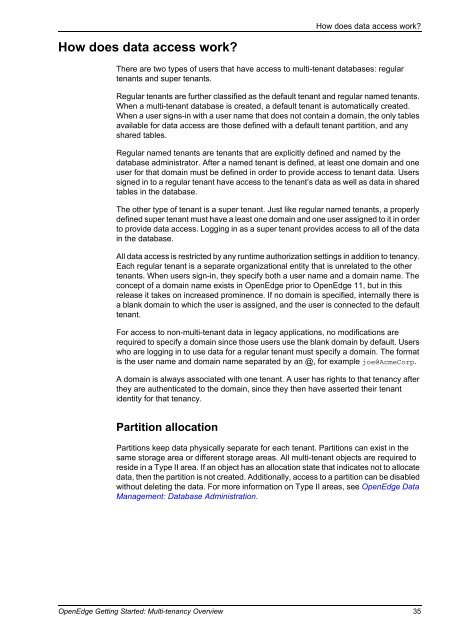OpenEdge Getting Started: Multi-tenancy Overview - Product ...
OpenEdge Getting Started: Multi-tenancy Overview - Product ...
OpenEdge Getting Started: Multi-tenancy Overview - Product ...
Create successful ePaper yourself
Turn your PDF publications into a flip-book with our unique Google optimized e-Paper software.
How does data access work?<br />
How does data access work?<br />
There are two types of users that have access to multi-tenant databases: regular<br />
tenants and super tenants.<br />
Regular tenants are further classified as the default tenant and regular named tenants.<br />
When a multi-tenant database is created, a default tenant is automatically created.<br />
When a user signs-in with a user name that does not contain a domain, the only tables<br />
available for data access are those defined with a default tenant partition, and any<br />
shared tables.<br />
Regular named tenants are tenants that are explicitly defined and named by the<br />
database administrator. After a named tenant is defined, at least one domain and one<br />
user for that domain must be defined in order to provide access to tenant data. Users<br />
signed in to a regular tenant have access to the tenant’s data as well as data in shared<br />
tables in the database.<br />
The other type of tenant is a super tenant. Just like regular named tenants, a properly<br />
defined super tenant must have a least one domain and one user assigned to it in order<br />
to provide data access. Logging in as a super tenant provides access to all of the data<br />
in the database.<br />
All data access is restricted by any runtime authorization settings in addition to <strong>tenancy</strong>.<br />
Each regular tenant is a separate organizational entity that is unrelated to the other<br />
tenants. When users sign-in, they specify both a user name and a domain name. The<br />
concept of a domain name exists in <strong>OpenEdge</strong> prior to <strong>OpenEdge</strong> 11, but in this<br />
release it takes on increased prominence. If no domain is specified, internally there is<br />
a blank domain to which the user is assigned, and the user is connected to the default<br />
tenant.<br />
For access to non-multi-tenant data in legacy applications, no modifications are<br />
required to specify a domain since those users use the blank domain by default. Users<br />
who are logging in to use data for a regular tenant must specify a domain. The format<br />
is the user name and domain name separated by an @, for example joe@AcmeCorp.<br />
A domain is always associated with one tenant. A user has rights to that <strong>tenancy</strong> after<br />
they are authenticated to the domain, since they then have asserted their tenant<br />
identity for that <strong>tenancy</strong>.<br />
Partition allocation<br />
Partitions keep data physically separate for each tenant. Partitions can exist in the<br />
same storage area or different storage areas. All multi-tenant objects are required to<br />
reside in a Type II area. If an object has an allocation state that indicates not to allocate<br />
data, then the partition is not created. Additionally, access to a partition can be disabled<br />
without deleting the data. For more information on Type II areas, see <strong>OpenEdge</strong> Data<br />
Management: Database Administration.<br />
<strong>OpenEdge</strong> <strong>Getting</strong> <strong>Started</strong>: <strong>Multi</strong>-<strong>tenancy</strong> <strong>Overview</strong> 35
















